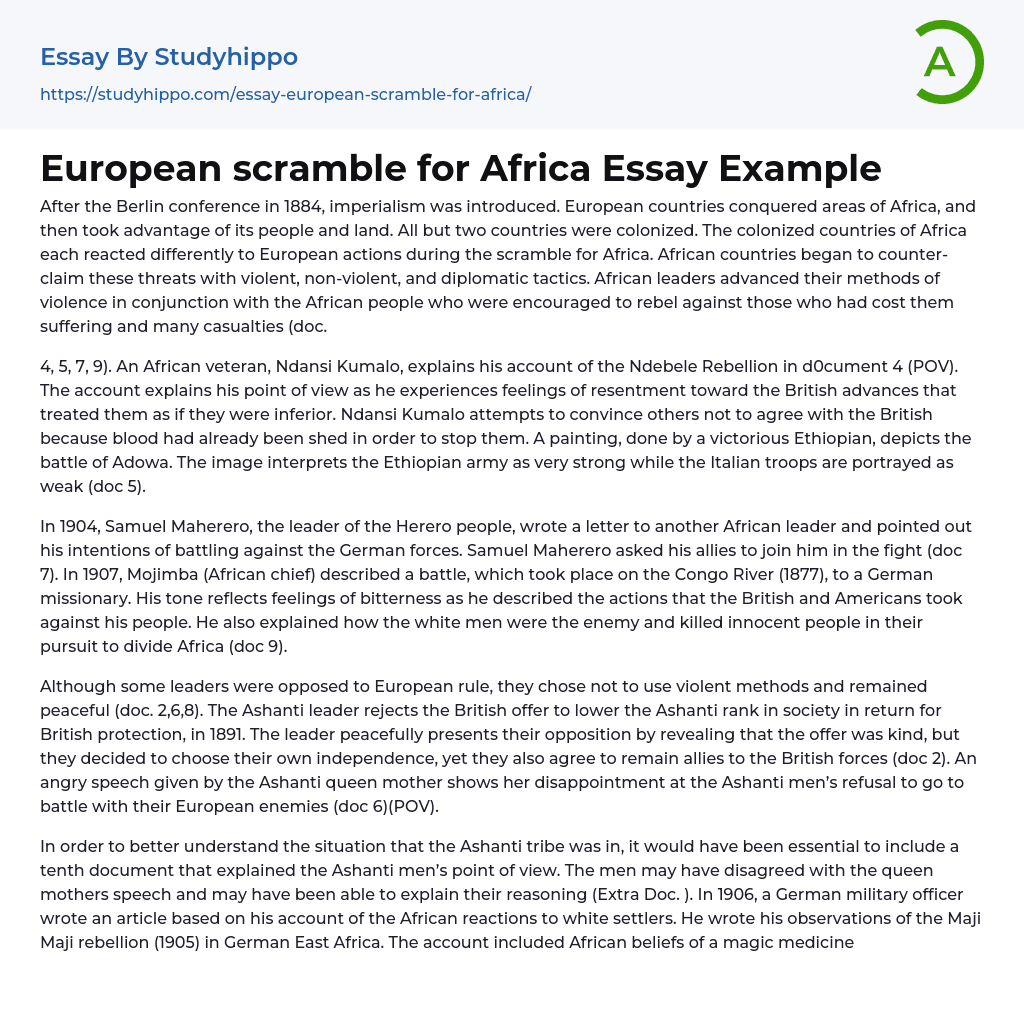After the Berlin conference in 1884, imperialism was introduced. European countries conquered areas of Africa, and then took advantage of its people and land. All but two countries were colonized. The colonized countries of Africa each reacted differently to European actions during the scramble for Africa. African countries began to counter-claim these threats with violent, non-violent, and diplomatic tactics. African leaders advanced their methods of violence in conjunction with the African people who were encouraged to rebel against those who had cost them suffering and many casualties (doc.
4, 5, 7, 9). An African veteran, Ndansi Kumalo, explains his account of the Ndebele Rebellion in d0cument 4 (POV). The account explains his point of view as he experiences feelings of resentment toward the British advances th
...at treated them as if they were inferior. Ndansi Kumalo attempts to convince others not to agree with the British because blood had already been shed in order to stop them. A painting, done by a victorious Ethiopian, depicts the battle of Adowa. The image interprets the Ethiopian army as very strong while the Italian troops are portrayed as weak (doc 5).
In 1904, Samuel Maherero, the leader of the Herero people, wrote a letter to another African leader and pointed out his intentions of battling against the German forces. Samuel Maherero asked his allies to join him in the fight (doc 7). In 1907, Mojimba (African chief) described a battle, which took place on the Congo River (1877), to a German missionary. His tone reflects feelings of bitterness as he described the actions that the British and Americans took against his people. He also explained
how the white men were the enemy and killed innocent people in their pursuit to divide Africa (doc 9).
Although some leaders were opposed to European rule, they chose not to use violent methods and remained peaceful (doc. 2,6,8). The Ashanti leader rejects the British offer to lower the Ashanti rank in society in return for British protection, in 1891. The leader peacefully presents their opposition by revealing that the offer was kind, but they decided to choose their own independence, yet they also agree to remain allies to the British forces (doc 2). An angry speech given by the Ashanti queen mother shows her disappointment at the Ashanti men’s refusal to go to battle with their European enemies (doc 6)(POV).
In order to better understand the situation that the Ashanti tribe was in, it would have been essential to include a tenth document that explained the Ashanti men’s point of view. The men may have disagreed with the queen mothers speech and may have been able to explain their reasoning (Extra Doc. ). In 1906, a German military officer wrote an article based on his account of the African reactions to white settlers. He wrote his observations of the Maji Maji rebellion (1905) in German East Africa. The account included African beliefs of a magic medicine that would ward off the enemy settlers (doc. 8).
The powers involved in the scramble for Africa responded with diplomacy when dealing with other countries (doc. 1,2,3). Document 1 introduces a contract written from the British government to the royal Niger Company, in 1886. The document explains the British intent on expanding their own land
by asking for portions of the Niger River delta. This contract is an example of formal communication between the British government and various African tribes along the Niger River delta. Another instance of peaceful communication applies to document 2. The document is a response to British offers to bring the Ashanti tribe under their protection.
The tribe leader decides to decline and remain an independent tribe, yet the tribe would also like to remain friends with all white men. The emperor of Ethiopia reaches out to the European countries involved in the scramble for Africa in 1891 (doc. 3). In this letter, from Menelik II (emperor), he describes that he has faith in his god, to protect his people and their land, although other Muslim forces had attacked it in the past. In conclusion, the documents recording the actions and reactions of the involved countries during the scramble for Africa can be arranged into groups of violence, diplomacy and non-violence.
- South Africa essays
- Nigeria essays
- Victorian Era essays
- Henry v essays
- Stonehenge essays
- Air Force essays
- Army essays
- Soldiers essays
- Army Values essays
- United States Army essays
- Veteran essays
- Aircraft essays
- Sergeant essays
- World War I essays
- World War Ii essays
- Atomic Bomb essays
- American Civil War essays
- Attack essays
- Cold War essays
- Crimean War essays
- Emilio Aguinaldo essays
- Iraq War essays
- Korean War essays
- Nazism essays
- Nuclear Weapon essays
- Philippine Revolution essays
- Trench Warfare essays
- Vietnam War essays
- Western Front essays
- Diplomacy essays
- Emperor essays
- Rwanda essays
- Tribe essays
- Revolutionary War essays
- War of 1812 essays
- Mexican American War essays
- Hitler essays
- The Spanish American War essays
- League Of Nations essays
- Battle Of The Somme essays
- Treaty Of Versailles essays
- Fascism essays
- D-day essays
- Atomic Physics essays
- Atomic Bombings Of Hiroshima And Nagasaki essays
- Electron essays
- Afghanistan essays
- Africa essays
- America essays
- Asia essays




